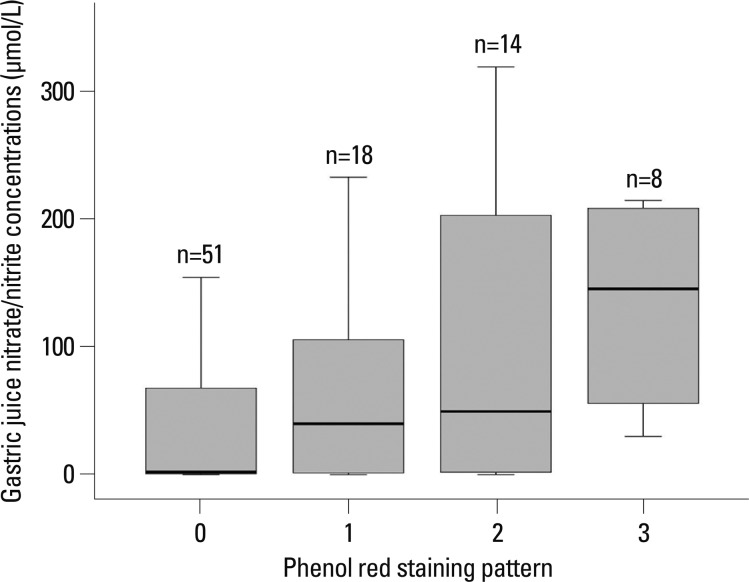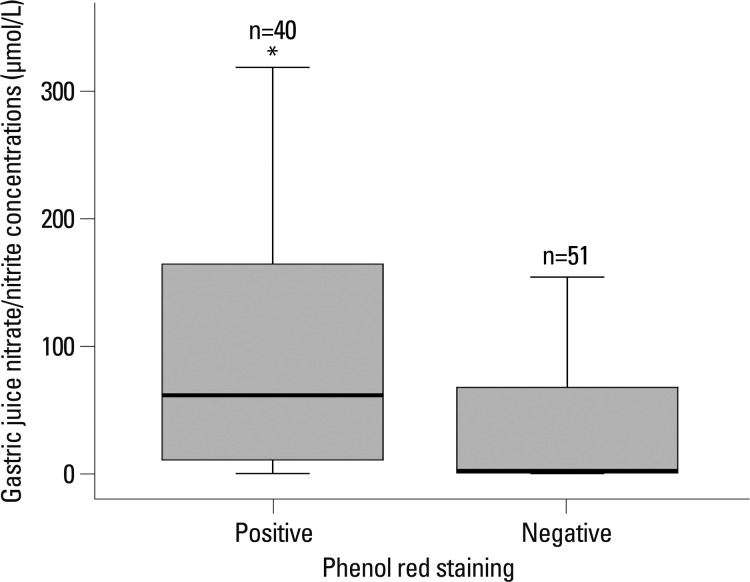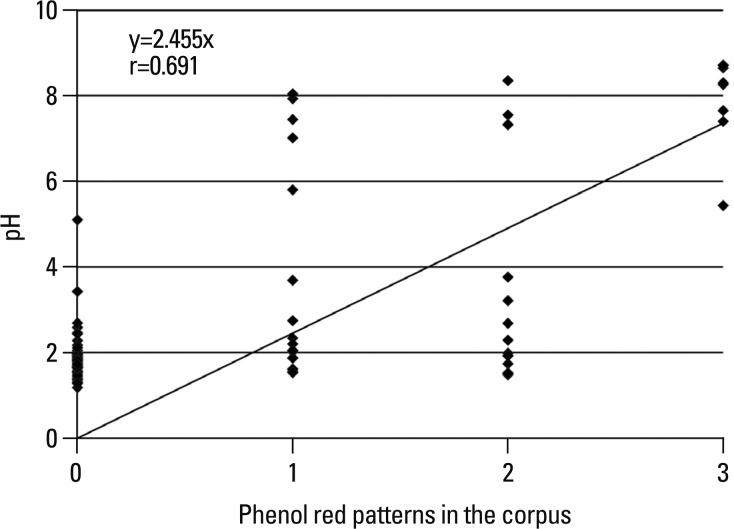Yonsei Med J.
2012 Nov;53(6):1154-1158. 10.3349/ymj.2012.53.6.1154.
The Relationship between Gastric Juice Nitrate/Nitrite Concentrations and Gastric Mucosal Surface pH
- Affiliations
-
- 1Department of Laboratory Medicine, The Catholic University of Korea College of Medicine, Seoul, Korea.
- 2Department of Internal Medicine, The Catholic University of Korea College of Medicine, Seoul, Korea. chs@catholic.ac.kr
- 3Department of Pathology, The Catholic University of Korea College of Medicine, Seoul, Korea.
- 4Myung Sung Pathology, Seoul, Korea.
- KMID: 1414258
- DOI: http://doi.org/10.3349/ymj.2012.53.6.1154
Abstract
- PURPOSE
To investigate gastric juice nitrate/nitrite concentration according to mucosal surface pH extent (area) of gastric corpus intimately contacting the gastric juice.
MATERIALS AND METHODS
We included ninety-nine patients with dyspepsia. To evaluate gastric mucosal surface pH and its extent, gastric chromosocpy was performed by spraying phenol red dye on the corpus mucosa and estimating the extent of area with color changed. Nitrate/nitrite concentrations and pH of gastric juice were measured by ELISA and pH meter, respectively. Silver staining was done to histologically confirm the presence of Helicobacter pylori.
RESULTS
Intragastric nitrate/nitrite concentrations in patients, showing phenol red staining mucosa were higher than those of unstaining mucosa (p=0.001): the more extensive in the area of phenol red staining area of corpus, the higher gastric juice pH found (r=0.692, p<0.001). Furthermore, the intragastric nitrate/nitrite concentrations correlated positively with gastric juice pH (r=0.481, p<0.001).
CONCLUSION
The changes of mucosal surface pH and its extent in gastric corpus might affect either pH or nitrate/nitrite level of gastric juice.
Keyword
MeSH Terms
Figure
Reference
-
1. Iijima K, Fyfe V, McColl KE. Studies of nitric oxide generation from salivary nitrite in human gastric juice. Scand J Gastroenterol. 2003; 38:246–252. PMID: 12737438.
Article2. Shiotani A, Iishi H, Kumamoto M, Nakae Y. Helicobacter pylori infection and increased nitrite synthesis in the stomach. Inflammation and atrophy connections. Dig Liver Dis. 2004; 36:327–332. PMID: 15191201.3. Shiotani A, Yanaoka K, Iguchi M, Saika A, Itoh H, Nishioka S. Helicobacter pylori infection reduces intraluminal nitric oxide in humans. J Gastroenterol. 1999; 34:668–674. PMID: 10588182.
Article4. Schlag P, Böckler R, Peter M. Nitrite and nitrosamines in gastric juice: risk factors for gastric cancer? Scand J Gastroenterol. 1982; 17:145–150. PMID: 7134831.
Article5. Reed PI, Smith PL, Haines K, House FR, Walters CL. Gastric juice N-nitrosamines in health and gastroduodenal disease. Lancet. 1981; 2:550–552. PMID: 6116002.
Article6. Risch HA, Jain M, Choi NW, Fodor JG, Pfeiffer CJ, Howe GR, et al. Dietary factors and the incidence of cancer of the stomach. Am J Epidemiol. 1985; 122:947–959. PMID: 2998182.
Article7. González CA, Riboli E, Badosa J, Batiste E, Cardona T, Pita S, et al. Nutritional factors and gastric cancer in Spain. Am J Epidemiol. 1994; 139:466–473. PMID: 8154470.8. Tari A, Kodama K, Sumii M, Tani H, Sumii K, Chayama K. Does intragastric nitrite concentration reflect gastric carcinogenesis in Japanese Helicobacter pylori-infected patients? Dig Dis Sci. 2003; 48:1730–1736. PMID: 14560992.9. McKnight GM, Smith LM, Drummond RS, Duncan CW, Golden M, Benjamin N. Chemical synthesis of nitric oxide in the stomach from dietary nitrate in humans. Gut. 1997; 40:211–214. PMID: 9071933.
Article10. Jonkers D, Houben P, Hameeteman W, Stobberingh E, de Bruine A, Arends JW, et al. Differential features of gastric cancer patients, either Helicobacter pylori positive or Helicobacter pylori negative. Ital J Gastroenterol Hepatol. 1999; 31:836–841. PMID: 10669990.11. Kondo T, Mitsui T, Kitagawa M, Nakae Y. Association of fasting breath nitrous oxide concentration with gastric juice nitrate and nitrite concentrations and Helicobacter pylori infection. Dig Dis Sci. 2000; 45:2054–2057. PMID: 11117583.12. Oldreive C, Rice-Evans C. The mechanisms for nitration and nitrotyrosine formation in vitro and in vivo: impact of diet. Free Radic Res. 2001; 35:215–231. PMID: 11697121.13. Lee HK, Kim H, Chae HS, Choi SS, Kim HK, Cho YS, et al. Differences of urease activity and expression of associated genes according to gastric topography. Helicobacter. 2011; 16:20–26. PMID: 21241408.
Article14. Miederer SE, Grübel P. Profound increase of Helicobacter pylori urease activity in gastric antral mucosa at low pH. Dig Dis Sci. 1996; 41:944–949. PMID: 8625767.15. Cho YS, Chae HS, Jang SN, Kim JS, Son HS, Kim HK, et al. Comparison of the 13C-urea breath test and the endoscopic phenol red mucosal pH test in the quantification of Helicobacter pylori infection loading. Korean J Intern Med. 2008; 23:134–139. PMID: 18787366.
Article16. Kohli Y, Kato T, Iwaki M, Yamazaki Y, Hata M, Suzuki K, et al. The distribution of Helicobacter pylori in human gastric mucosa in vivo. Dig Endosc. 1991; 3:457–460.
Article17. Green LC, Wagner DA, Glogowski J, Skipper PL, Wishnok JS, Tannenbaum SR. Analysis of nitrate, nitrite, and [15N]nitrate in biological fluids. Anal Biochem. 1982; 126:131–138. PMID: 7181105.
Article18. Watt PC, Sloan JM, Donaldson J, Campbell G, Kennedy TL. Relation between gastric histology and gastric juice pH and nitrite and N-nitroso compound concentrations in the stomach after surgery for duodenal ulcer. J Clin Pathol. 1984; 37:511–515. PMID: 6725597.
Article19. Mowat C, Williams C, Gillen D, Hossack M, Gilmour D, Carswell A, et al. Omeprazole, Helicobacter pylori status, and alterations in the intragastric milieu facilitating bacterial N-nitrosation. Gastroenterology. 2000; 119:339–347. PMID: 10930369.
Article20. Kodama K, Sumii K, Kawano M, Kido T, Nojima K, Sumii M, et al. Gastric juice nitrite and vitamin C in patients with gastric cancer and atrophic gastritis: is low acidity solely responsible for cancer risk? Eur J Gastroenterol Hepatol. 2003; 15:987–993. PMID: 12923371.
- Full Text Links
- Actions
-
Cited
- CITED
-
- Close
- Share
- Similar articles
-
- Correlations Among Gastric Juice pH and Ammonia, Helicobacter Pylori Infection and Gastric Mucosal Histology
- Associations among Gastric Juice pH, Atrophic Gastritis, Intestinal Metaplasia and Helicobacter pylori Infection
- Effects of Preoperative Oral Fruit Juices on Gastric olume and pH in Children
- A Comparison of the Effects of Cimetidine, Ranitidine and Famotidine as Premedication on Gastric Volume and pH
- Effects of Preoperative Clear Fluid Intake and Concomitant Administration of Ranitidine on Gastric Volume and pH




